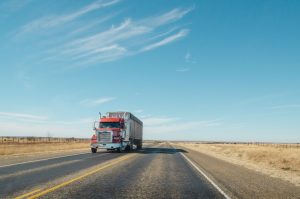I know what it’s like to get a big piece of machinery unstuck: ì§„í™ ë°ì—ì„œ 콤바ì¸ì„ 뽑기 위해 트랙 ê´ì´ë¥¼ 사용해야했습니다., and I’ve seen up close how a minor catastrophe like this can stop the entire process for farmers who want to harvest their crops.
 ë¬¼ë¡ ì´ì•¼, that’s nothing compared to what just happened in the Suez Canal, where a 1,300-foot container ship blocked a significant maritime passage between Asia and Europe for nearly a week, disrupting global trade—and providing a vivid reminder of how much we depend on transportation networks that are really quite vulnerable.
ë¬¼ë¡ ì´ì•¼, that’s nothing compared to what just happened in the Suez Canal, where a 1,300-foot container ship blocked a significant maritime passage between Asia and Europe for nearly a week, disrupting global trade—and providing a vivid reminder of how much we depend on transportation networks that are really quite vulnerable.
We were all fascinated by the saga of the ship that ran aground in the Suez Canal on March 23, possibly due to high winds or a technical error, as it trekked from Malaysia to the Netherlands. Launched less than three years ago, the Ever Given is one of the largest container vessels in the world, weighing more than 220,000 gross tons.
Its predicament made for suspenseful television, and most people could relate to some aspect of the dilemma. My mind turned to the muddy mishap on my farm. Anybody who has ever been caught in a congested traffic jam knows how a bad bottleneck can frustrate travel plans.
We’ve also been reminded yet again about the fragility of our infrastructure. 약 13 percent of global trade flows through the Suez Canal. Analysts are already trying to calculate the economic damage done by the blockage of the waterway, as ships suffer from delays and re-routing. It could take weeks or months to recover fully.
In North America, many of us will not see the effects of the obstruction directly, but we may feel them indirectly as transportation prices around the world increase for everyone. Container fees were soaring long before the accident in the Suez Canal, and now they’ll continue to shoot upward as they work to get containers emptied and relocated. 예를 들어, this will affect agriculture products that are shipped overseas in containers, like Dried Distillers Grains (DDGS), an ethanol by-product that is a high-protein livestock feed.
As a US grain farmer, we also have our own challenges. A large portion of the soybeans that I grow as a farmer in Iowa is bound for customers in other countries. Exporting these grains requires a vigorous system of infrastructure—one that we can’t afford to take for granted.

Rural broadband access connects me with the wider world. So do the gravel roads that support the semi-trailers that haul the crops from my farm. Next come the barges on the Mississippi River, ì–´ë”” 29 locks and dams allow shipments to float south to New Orleans and the wider world—oftentimes through the Panama Canal, which is as vital to the New World as the Suez Canal is to the Old World.
The Panama Canal has needed an upgrade for years. Yet there’s an even bigger problem closer to home. The locks and dams of the Mississippi River are in a constant state of disrepair. When they were built in the 1930s, they were supposed to function for about 50 ì—°ë ¹. Soon they’ll be twice as old as their original life expectancy.
 They’re already starting to fail. Their unreliability hurts our economy all the time. 지난주, a lock-and-dam system in Illinois shut down when a couple of barges slammed into a lock. I was supposed to send multiple semi-truck loads of grain to the river for shipment overseas this week—but now I can’t, because construction work has prevented barges from moving upriver. We’re told to expect a delay of two or three weeks.
They’re already starting to fail. Their unreliability hurts our economy all the time. 지난주, a lock-and-dam system in Illinois shut down when a couple of barges slammed into a lock. I was supposed to send multiple semi-truck loads of grain to the river for shipment overseas this week—but now I can’t, because construction work has prevented barges from moving upriver. We’re told to expect a delay of two or three weeks.
Compared to the mess in the Suez Canal, this is a tiny inconvenience—but it’s also the kind of malfunction that has become normal, in an ongoing aggravation that slows down the ability of American farmers to compete with and sell to the rest of the world.
The solution is to pay more attention to our infrastructure. President Biden’s new $3 trillion spending proposal includes about $1 trillion for infrastructure. It’s important that we do not forget or neglect the transportation infrastructure like barge and rail that have gotten this country to where it is today. It may not be new and sexy but it’s still the most efficient way to handle the volumes of freight going across, in and out of this country that we all depend on.
I don’t know how it will finish; I just hope it doesn’t run aground.
_________________________________________________________________________________________________________
후보작 후보ìžë¥¼ 위해 수ë½ë˜ê³ 있습니다 2021 글로벌 ë†ë¶€ ë„¤íŠ¸ì›Œí¬ ì›íƒ íšŒì˜ ë° ë¦¬ë”ì‹ êµìœ¡. ì—¬ë¦„ì— ìž ì • 개최 ì˜ˆì • 2021, ë‹¤ìŒ ë¼ìš´ë“œ í…Œì´ë¸”ì—는 브뤼셀ì—ì„œ ì§ì ‘ 만나기 ì „ì— ê°€ìƒ êµ¬ì„± 요소가 í¬í•¨ë©ë‹ˆë‹¤., 벨기ì—. 대면 ì´ë²¤íŠ¸ ë‚ ì§œëŠ” ì—¬í–‰ì´ í—ˆìš©ë˜ê³ ì‚¬ëžŒë“¤ì´ ì•ˆì „í•˜ë‹¤ê³ ëŠë¼ëŠ”ì‹œê¸°ì— ë”°ë¼ ë‹¤ë¦…ë‹ˆë‹¤.. ì´ë²¤íŠ¸ì— 대해 ë” ì•Œì•„ë³´ê¸° 여기.
여기를 í´ë¦í•˜ì‹ì‹œì˜¤ 글로벌 파머 네트워í¬ì— 기부.
GFNì´ ë†ë¯¼ë“¤ì´ ê°•ë ¥í•œ 목소리를 통해 ì•„ì´ë””어를 ê³µìœ í• ìˆ˜ 있ë„ë¡ ì§€ì›í•˜ëŠ” ë°©ë²•ì— ëŒ€í•´ ìžì„¸ížˆ 알아보기, ë”¸ê¹ í•˜ëŠ” 소리 여기.


